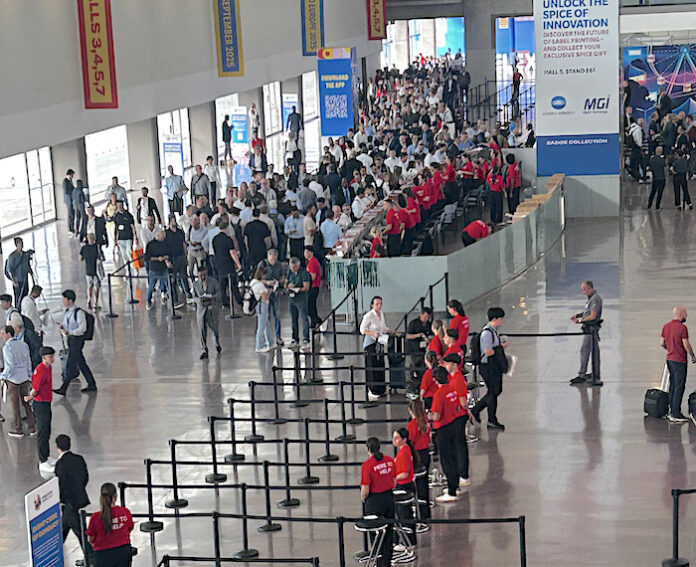It would be foolish to try to sum up the Labelexpo in Barcelona in a single catchy phrase. The caravan that carries its seven shows (notably two in China) to locations on four continents, moved its mother event from Brussels to Barcelona. To be fair, both cities have historical and cultural virtues, as well as political legacies, that deserve comment. I will only say that Barcelona is more interesting architecturally, not only because it is the city of Gaudí, but because the Brussels exhibition site built for the 1935 World’s fair is reminiscent of an oversized monumental Art Deco architectural era – a grey and monstrous facade not unlike the main railway station in Milan of 1931.
In our September 16 report, we mentioned Durst, Gallus, and Epson, suggesting that digital label and hybrid presses were attracting a higher share of visitors on the morning of the first day. By the end of the show, we were able to have a look at the narrow web flexo, ancillary equipment, consumables, security and decoration suppliers, as well as at some of the new inkjet, flexo, hybrid and offset presses for labels and flexible packaging at the show. Apart from these, consumables, technologies for metallic decoration, and those that combine metallic decoration with security features are of great interest.
In the second part of our coverage, we describe some of the show’s wider flexo and hybrid presses for labels and flexible packaging. In the next reports, we will talk about some of the security, track & trace, decoration, and metallic solutions, software technology, and consumable and ancillary suppliers at the show. Our colleague Nessan Cleary’s technical insights will simultaneously appear in this space in the coming days.
Bobst
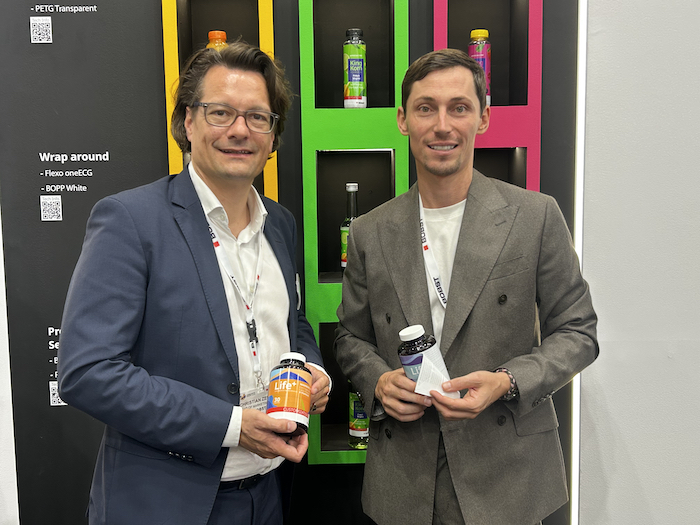
While Bobst didn’t show any machines at the show, it emphasized its keenness and ability to partner with converters as they diversify and expand their operations to short-run and special applications, particularly with its digital Flexjet monochrome module for producing multilayer labels in a single pass.
The Flexjet module is a monochrome 1200 x 1200 inkjet option available for its Digital Master 340 and 510 platforms. It delivers an industry-first digital multilayer solution featuring multiple digital print units working in line. The fully integrated workflow enables single-pass production of complex label jobs such as multilayer, glue- and back-side printing.
The Flexjet module is currently equipped with one black printbar, using Bobst’s inkjet technology, using Fujifilm Dimatix Samba printheads for output at 1200 x 1200 dpi resolution at full process speed. This enables converters to print independently on the front, back, liner, or adhesive surfaces, all in a single pass.
As Patrick Graber, Bobst’s marketing director for labels, told us, “We’re seeing significant growth in the demand for multilayer applications driven by a large number of factors – such as sustainability and regulatory requirements, including product information, nutritional and ingredient values, and information, contra-indications and warnings in multiple languages. There is increasing demand for adding promotional content and interactive features. While Bobst already provides innovative solutions for producing multilayer labels using inline flexo and all-in-one machines, it is now offering a fully digital solution with Flexjet, which pushes digital printing beyond its traditional limits.”
Gallus
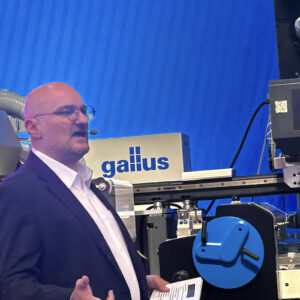
On the Gallus stand at Labelexpo, Dario Urbanati spoke about the company’s modular concept, giving it the ability to configure and integrate technologies from its approximately twenty partners. Two new presses were announced, firstly, the Gallus Five, a high-performance hybrid press, integrating digital flexibility with industrial-level productivity that is available for order but will be delivered in six months. It was shown on the stand with a Kurz inline foiler. This is likely to be an interesting press for Indian converters who are keen to differentiate their offerings with inline decoration capabilities together with high-volume throughput of complex and short-run jobs, after it is tested amongst early adopters in Europe and made available in this market.
The second new machine is the Gallus Alpha, a compact digital-only press for entrants into digital label production. The Alpha is also available to configure and order, with delivery anticipated in a three-month timeframe. Experience indicates that as the first press is going into a beta site, the Alpha could take as long as three or four quarters before it reaches South Asian shores, but it looks like an interesting press for a high-quality entry into digital labels. While the two new presses demonstrated at the Gallus stand will take considerable time to reach Indian converters, the company has several Labelmaster press orders on hand, and some interesting news that we hope to share with our readers in detail in the coming days.
Mark Andy
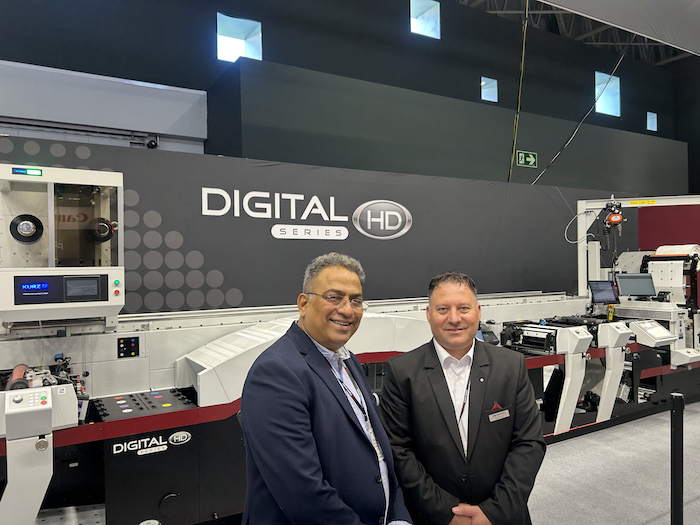
At its large stand at Barcelona, Mark Andy demonstrated a fleet of four presses designed as targeted solutions to meet the increasingly complex demands for labels, flexible packaging, and digital and hybrid productivity for short runs. On the stand was the Performance series P9 press, a 660 mm sleeve press aimed at both labels and mid-web flexible packaging. This press is quite a step up from the Performance series P7 press, of which there are already 55 installations in India.
A highlight at the stand was the DSHD HighSpeed 1200 hybrid press, claimed to be the industry’s fastest 1200dpi solution, delivering digital quality at speeds up to 146 meters a minute. The press, which is popular in Europe and North America, with 150 already sold, is built on the P7 platform and features Ricoh Gen 5 inkjet heads. It was shown in a flexo + flexo + digital CMYK + flexo + flexo + converting, configuration.
The Pro Series, a new fully servo-driven flexo platform engineered for short-run label production, offers quick changeovers, low waste, and a modular design that is said to be adaptable, was shown for the first time. Meant to be an entry-level press for self-adhesive stock up to 200 microns, it can also run board stock and is available in 43 cm and 33 cm widths.
The Digital Pro MAX, a toner-based hybrid based on a Konica Minolta engine, and the Rotoflex VLI, a high-speed inspection and rewinding system for film, tension-sensitive materials, and advanced label finishing, rounded out the equipment demonstrations at the stand.
Speaking to Florian Stroe, Mark Andy’s Technical Sales manager based in the UK and Gourov Roy managing director of FIG, Mark Andy’s South Asia distributor for 25 years, we learnt that the Mark Andy Performance P7 is the flagship in the Indian market while the Evolution is currently the most popular press at the entry level with 8 or 9 installations in the country. Roy suggested that the new Pro press is ideal for the Indian market.
Roy said that FIG services an installed base of 320 Mark Andy presses in South Asia, with 125 Rotoflex and 170 Rhyguan machines. The company’s employees include more than 40 engineers and technicians for installation and services, and a large number of annual contracts for preventive maintenance.
MPS
At Labelexpo Barcelona, MPS offered a sneak peek at its new EF Packaging platform that adds enhanced mid-web capabilities, better automation, and robust connectivity through MPSConnect, building on its EF label press platform. The new EF Packaging press is particularly designed for flexible packaging, in-mold, wraparound labels, and shrink sleeves. At the show, it demonstrated its Performance Ecosystem, a visual framework for machine data and performance that looks at operator skills, workflow optimization, and machine performance. Its data and insights are claimed to show a clear and actionable path to efficiency.
“The EF Packaging is about giving our customers the opportunities to say ‘yes’ to expand their product portfolio and explore more business opportunities in new segments —with a press that offers all the benefits our EF Flagship press enabling the lowest cost per print, at the highest speeds and quickest change-overs that MPS is known for,” said Richard Miedema, Global Sales Director at MPS.
Multitec
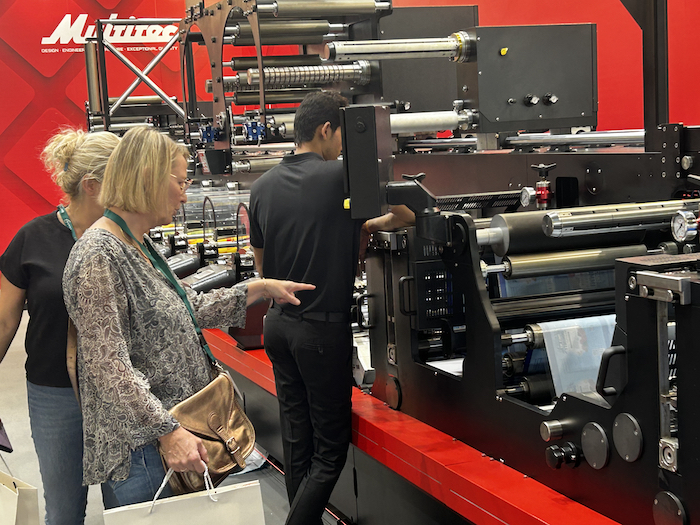
The prominent Multitec stand right at the entrance of the show in Hall 3 attracted a good number of the company’s customers and distributor agents from around the world. Its 200 meters a minute demonstrations of the fully-servo mid-web S3S sleeve-based 8–color flexo press printing on thin substrates for flexible packaging attracted crowds. The fully automated press is leveraging demand from label converters moving into flexible packaging for shrink sleeves, small pouches, as well as the high growth of short runs, especially from startup brands.
The S3S can comfortably print complex designs on substrates ranging from 10-micron films to light monocartons, while maintaining extremely high register accuracy. Its short-run advantages start from origination and prepress costs in comparison with gravure, ultra-fast job changeovers in under four minutes, and extremely low setup and makeready waste with zero-gap jointless printing. The live demonstrations throughout the show in Barcelona demonstrated that converters can achieve quality, agility, and profitability in applications previously considered unviable with flexo – and also without breaking the bank.
Multitec has over 680 flexo press installations in 47 countries so far, including several installations in Europe in the past year. The S3S is particularly well-suited for short-run flexible packaging, including wraparound labels for the beverage industry and for prelaminated materials and pouches for food, confectionery, personal care, and agro products. Its geographically diverse customers see it as a workhorse for in-mold labels, lamitubes, self-adhesive labels, specialty films, and shrink sleeves. Near the end of the show, Multitec’s managing director Amit Ahuja commented that the show moving to Barcelona seemed to have brought in label converters from new areas and, most importantly, several serious leads to follow up after the show.
Spande S7 8-color hybrid for Citrus Packaging in Hyderabad
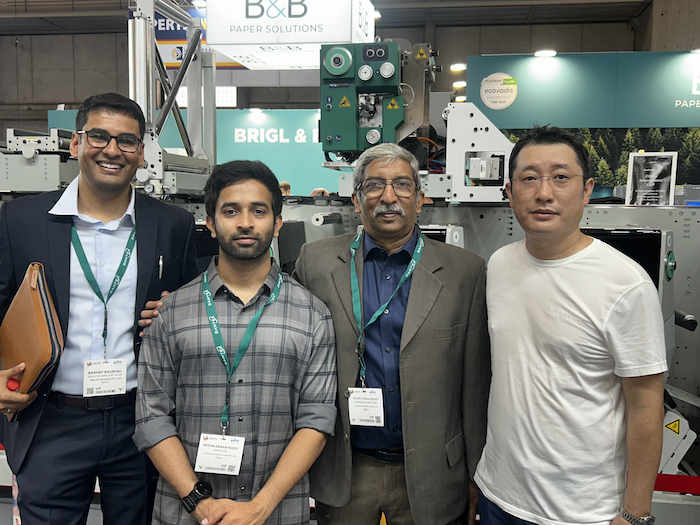
One of the highlights at Labelexpo was the demonstration of the Spande S7 8-color press containing two die-cutting stations and a lamination unit, apart from the flexo units. The press on the stand will go to a unit being established by Citrus Packaging, which currently specializes in pharma single and multilayer labels and medical hangar labels, at a new location in Hyderabad aimed at smart labels, and application development in printed electronics, including RFIDs.
The S7 8-color flexo press has chilled impression cylinders for printing on thin and extensible materials. Each unit has multiple servo motors, and its iPressure feature automatically adjusts the pressure between the anilox and the printing sleeve and between the printing sleeve and the anvil (impression) roller. The iVision feature is an intelligent autoregister system that matches changes in production speeds without any manual intervention. The press has a hybrid curing system using a combination of LED-UV, UV, and hot air cassettes. As shown in Barcelona, the press also has a digital printing unit.
The S7 press has a sheeter for carton production, although mostly labels are likely to be produced on the press. With a sheeter and conveyor to be attached at the end of the press when needed, the press can handle and print on 450 gsm board, while it can handle labelstock, unsupported films, and paper and board substrates in thicknesses between 12 and 450 microns.
In our conversation with Citrus’s founder, Chenga Reddy, and his son Abhiram Reddy, who has done his postgraduate diploma in printed electronics, the discussion veered to the consolidation of the label industry and the need for converters to reach out to clients and brand owners. Reddy spoke of the challenges in skilled manpower, suggesting that the new Spande press will help in reducing resources since it requires less or no human intervention in operation.
He added, “While we, the current management, are preoccupied with the day-to-day operations, we have launched Citrus Innovations with the purchase of the new Spande press, for applications such as RFID inlays and labels without having a single customer in hand. The RFID labels, tags, and solutions will be aimed at emerging segments such as retail garments, high-value luxury products, and the pharma and medical device industry segments.”
The Barcelona Fira is a good move, not just architecturally to a lighter and more modern space with accessible open-air terraces, but according to exhibitors one spoke to, it is a bit more ‘south’ – a bit warmer and sunnier and also perhaps more approachable to label and packaging converters from Southern Europe, Africa, Latin America and Asia. The ability of the organizers to effect the change reflects their agility and their ability to maintain the loyalty of their exhibitor and converter constituencies. And while the early indications are positive, the ambition to expand the caravan to cartons and flexible packaging (beyond labels) is still a work in progress in the fragmented industrial, political, and global trade environment.




